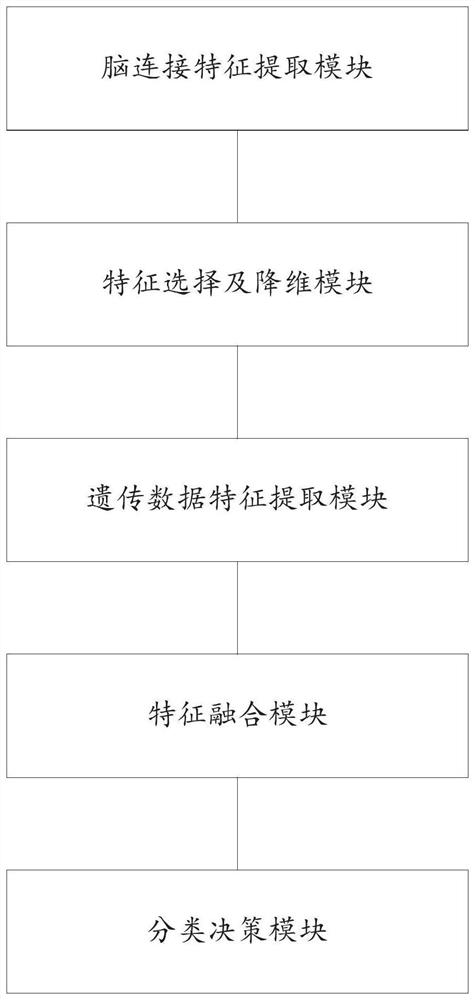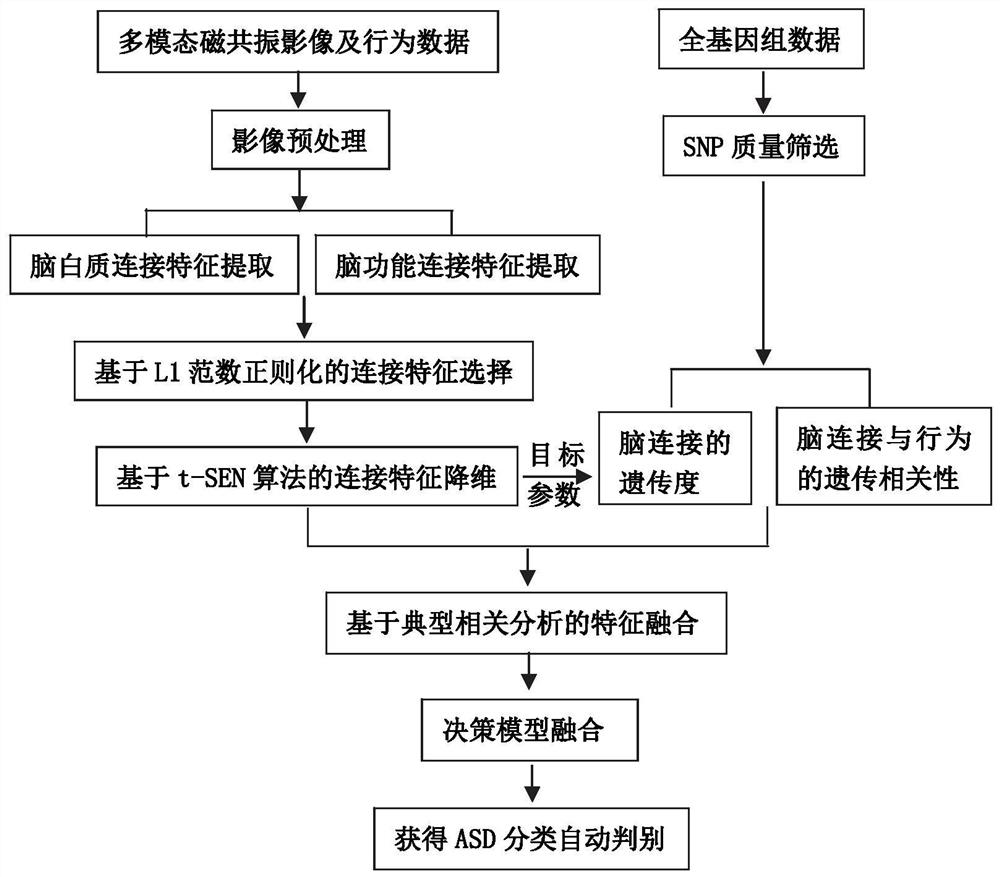Automatic distinguishing system for autism spectrum disorder, storage medium and equipment
A technique for autism and pedigree, which is applied in medical automated diagnosis, proteomics, character and pattern recognition, etc., can solve the problems of low accuracy rate, inability to provide reliable auxiliary diagnosis for early ASD diagnosis, single analysis features, etc., to achieve Improve the accuracy of discrimination, good learning effect, and improve the effect of classification accuracy
- Summary
- Abstract
- Description
- Claims
- Application Information
AI Technical Summary
Problems solved by technology
Method used
Image
Examples
Embodiment 1
[0042] refer to figure 1 , a kind of automatic discriminating system of autism spectrum disorder of the present embodiment, it comprises:
[0043] (1) Brain connection feature extraction module, which is used to extract functional connection and white matter connection map from the multimodal magnetic resonance images of the subjects as brain connection features.
[0044] Among them, the subjects were from patients with autism spectrum disorders and normal controls from the ABIDE Phase I / II database, and their sMRI images, fMRI images and dMRI images were obtained respectively.
[0045] In one or more embodiments, the system for automatic discrimination of autism spectrum disorder further includes an image preprocessing module, which is used for preprocessing the multimodal magnetic resonance images of the subjects.
[0046] The preprocessing process of each modal feature is as follows:
[0047] For sMRI, ①manually adjust the origin of all sMRIs to the anterior joint point; ...
Embodiment 2
[0071] This embodiment provides a computer-readable storage medium, on which a computer program is stored, and when the program is executed by a processor, the following steps are implemented:
[0072] Extract functional connectivity and white matter connectivity maps from the multimodal magnetic resonance images of the subjects as brain connectivity features;
[0073] Sparse selection and nonlinear dimensionality reduction of brain connection features;
[0074] Based on the whole genome sequencing data of the subjects and the quality screening of single nucleotide polymorphisms, the genetic data features are extracted by using the genetic constraint maximum likelihood method;
[0075] Use the canonical correlation analysis method to fuse the brain connection features and genetic data features after selection and dimensionality reduction;
[0076] Input the fused features into the decision-making model to determine whether it belongs to the category of autism spectrum disorde...
Embodiment 3
[0080] This embodiment provides a computer device, including a memory, a processor, and a computer program stored on the memory and operable on the processor. When the processor executes the program, the following steps are implemented:
[0081] Extract functional connectivity and white matter connectivity maps from the multimodal magnetic resonance images of the subjects as brain connectivity features;
[0082] Sparse selection and nonlinear dimensionality reduction of brain connection features;
[0083] Based on the whole genome sequencing data of the subjects and the quality screening of single nucleotide polymorphisms, the genetic data features are extracted by using the genetic constraint maximum likelihood method;
[0084] Use the canonical correlation analysis method to fuse the brain connection features and genetic data features after selection and dimensionality reduction;
[0085] Input the fused features into the decision-making model to determine whether it belong...
PUM
 Login to View More
Login to View More Abstract
Description
Claims
Application Information
 Login to View More
Login to View More - R&D
- Intellectual Property
- Life Sciences
- Materials
- Tech Scout
- Unparalleled Data Quality
- Higher Quality Content
- 60% Fewer Hallucinations
Browse by: Latest US Patents, China's latest patents, Technical Efficacy Thesaurus, Application Domain, Technology Topic, Popular Technical Reports.
© 2025 PatSnap. All rights reserved.Legal|Privacy policy|Modern Slavery Act Transparency Statement|Sitemap|About US| Contact US: help@patsnap.com


